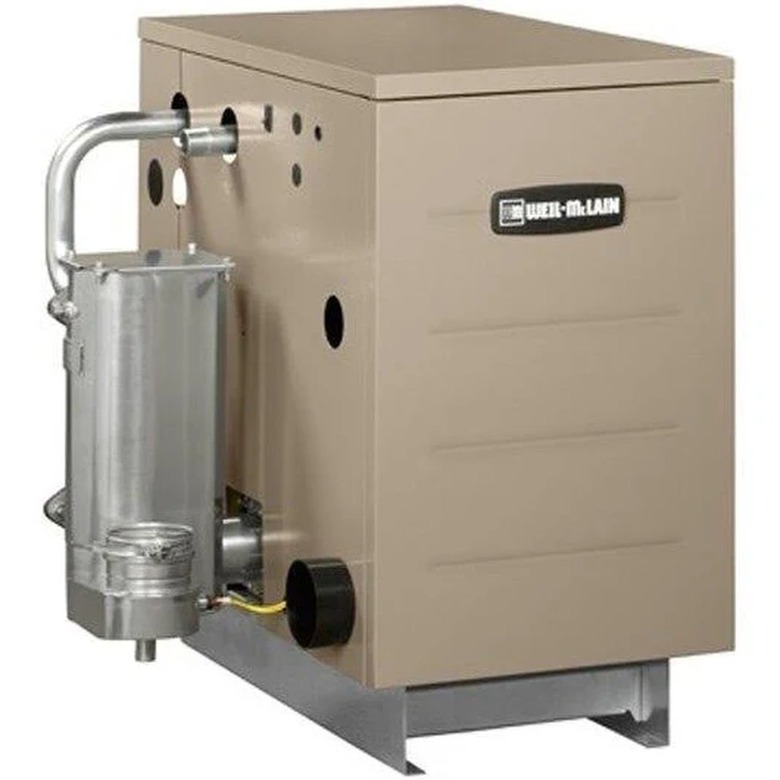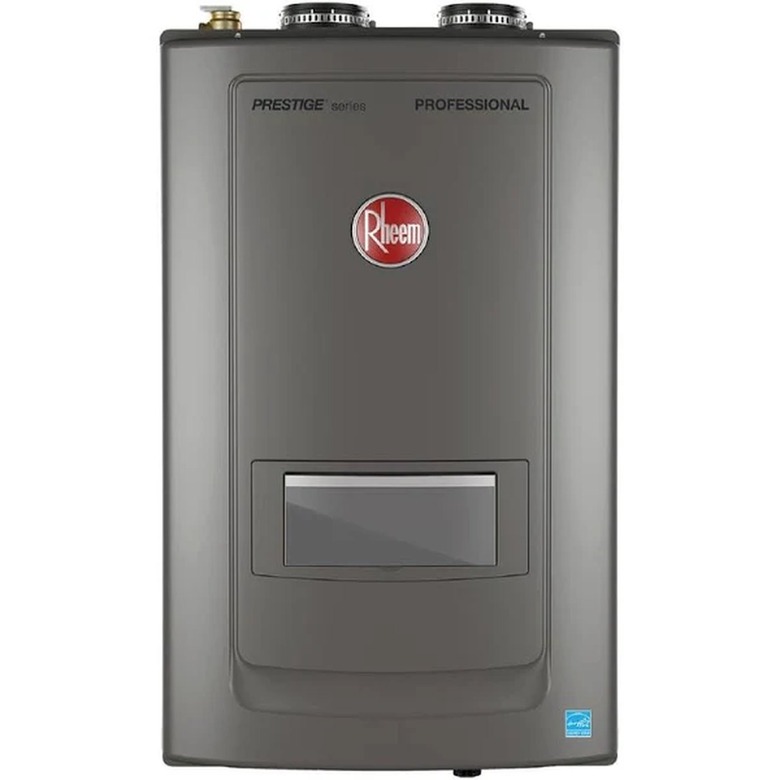Are High-Efficiency Boilers Worth It?
We may receive a commission on purchases made from links.
High-efficiency boilers, like high-efficiency furnaces, need to have an annual fuel efficiency rating (AFUE) of 90 percent or more to qualify for the high-efficiency label, and they are more expensive to install than standard-efficiency boilers. How much more expensive? About $4,000, according to professional HVAC contractors. Considering that the minimum boiler efficiency allowed is 82 percent for a gas boiler and 84 percent for an oil burner, that seems like a lot to pay for an 8 to 10 percent improvement in efficiency, but it actually isn't.
Some high-efficiency boilers that employ secondary heat exchangers to condense combustion gases and extract extra heat (called condensing boilers) can actually even have an AFUE rating as high as 99 percent. Even at first glance, that kind of efficiency justifies the higher price tag because it can significantly reduce your heating bill as well as the environmental impact of home heating. However, you also have to figure in higher installation costs — because condensing boilers are more complex than noncondensing boilers, requiring installation of a drain and vent through a sidewall.
If budget is your main concern, you'll probably ask whether upgrading to a high-efficiency boiler will pay for itself over the life of the boiler — and the answer is yes if you get a big enough break in energy savings. Putting economics aside, you'll be burning less fuel and doing your part to reduce consumption of natural resources. Since 2005, the United Kingdom has required all new boilers to be condensing boilers. As of 2021, the United States has not followed suit, but it might, so if you're installing a new boiler, it wouldn't hurt to make it a condensing boiler just in case.
Tip
In most cases, installing a high-efficiency boiler is worth the extra upfront costs because you usually make that back in energy savings in less than 10 years.
The Evolution of Boiler Systems
The Evolution of Boiler Systems
Homes that have boilers have hydronic heating systems, which means heat is delivered by hot water circulating through plumbing pipes. Whether the heating elements are radiators, baseboard heaters or pipes or tubing running through the floors, the heat source is the boiler, which looks and acts like a furnace, but unlike a furnace, it isn't connected to an HVAC system with ductwork, blowers and filters. Instead, all it has to do is heat water.
In an older boiler system, the boiler heats the water to the boiling point (that's why it's called a boiler), creating steam that rises naturally to the top of the system, where it condenses and falls back to the boiler. Steam boilers (along with gravity furnace systems) are becoming less common, and hot water boilers that have a circulation pump to cycle hot water through the pipes are becoming increasingly popular. The fact that a hot water boiler doesn't have to heat water to the boiling point is already an improvement in efficiency, and it avoids the problems that come with steam systems, such as burst pipes and airlocks as well as scalded fingers from purging steam from the system during maintenance.
Boilers themselves have changed over the years, following much the same trajectory as furnaces. Older boilers consisted of cast iron tanks and open-flame combustion systems and had dismal AFUE ratings in the neighborhood of 50 percent, meaning that half of the heat energy of the fuel was wasted. More contemporary standard-efficiency furnaces also often have cast iron tanks, and the combustion chamber has to be at least partially sealed to waste less energy and achieve the minimum required AFUE. High-efficiency condensing boilers are fully sealed and reclaim most of the exhaust gases for conversion back into heat. Because this process produces acidic water as a byproduct, condensing boilers have noncorroding stainless steel or aluminum tanks.
High-Efficiency Boilers and Condensing Boilers
High-Efficiency Boilers and Condensing Boilers
The difference between a standard high-efficiency boiler and a condensing boiler, which represents the gold standard in boiler efficiency, is how the system handles combustion gases. Noncondensing boilers are sealed and burn fuel more efficiently, but they release combustion gases through a metal flue just like standard-efficiency boilers. Condensing boilers, on the other hand, trap those gases in a secondary heat exchanger, where the gases condense and release extra heat that is used to heat the water.
This extra heat extraction process creates acidic condensate that has to be drained out of the system, so a condensing boiler actually has plumbing in the form of a drain line. It also needs a vent, but because the flue gases are cool and would corrode metal, the vent as well as the drain are made from PVC. Condensing boilers can burn natural gas, propane or heating oil, and all require the same setup. Fuel bills are usually higher for oil-burning boilers, but in some places, that's the only fuel available.
The installation of the drain and vent are two of the factors that increase the cost of replacing a conventional boiler with a condensing boiler. The job may require the services of a plumber in addition to the HVAC personnel working on the boiler itself. In addition, the installers have to make changes to the circulation pump, pipe system, expansion tank and air separator.
Cost of Boiler Replacement
Cost of Boiler Replacement
A number of factors over and above the extra costs of installing a condensing boiler figure into the cost of upgrading a conventional boiler to a high-efficiency one. These include:
- The size of the house
- The type of hydronic system the boiler services
- The location of the boiler
- Whether or not any piping has to be replaced
Homeowners who want to increase the energy efficiency of their home heating system to its maximum may want to opt for a combi-boiler that doubles as a water heater, and that will probably require retrofits to some of the plumbing pipes. Combi-boilers also cost more than conventional ones.
If you decide to replace an oil boiler with a gas one or vice versa, you'll be paying a higher upfront cost, particularly if you install a new one that burns natural gas. You'll have to dig trenches and install gas supply pipes, remove the old oil tank and install a new gas meter. All this extra work — minus removal of the oil tank — will be required if you switch from propane to natural gas.
All in all, the cost to replace a cast iron boiler with another cast iron boiler falls in a range of $5,000 to $12,000, with the average cost being $7,500. If you opt for a high-efficiency ENERGY STAR boiler with a stainless steel or aluminum tank, the cost will be between $9,000 and $15,000, with the average coming in at around $11,500.
A Tradeoff in Energy Savings
A Tradeoff in Energy Savings
A high-efficiency boiler uses less fuel and has lower emissions than a conventional one, and that's good for the environment, but the main reason most homeowners would want one is to reduce energy costs. The question they have to ask is whether the energy savings are enough to justify the extra cost of a high-efficiency boiler. That depends in no small part on the relative efficiencies of the old and new boilers as well as the average cost to run the boiler. The homeowners most likely to save money by installing a high-efficiency unit are those with older models that meet the bare-minimum efficiency requirements for standard boilers.
Suppose you have a natural gas boiler with an AFUE rating of 82 percent that costs $800 a month to operate. If you replace it with a high-efficiency model with an AFUE of 90, the difference in efficiency is 10 percent, so you'll save $80 on your monthly heating bills, and over the course of a six-month winter, you'll save almost $500. If the boiler costs $4,000 more to install than a conventional one, you'll make that up in a little over eight years. Now, consider a maximum-efficiency condensing boiler with an AFUE rating of 99 percent. It's more than 20 percent more efficient, saving you $160 per month or more and reducing the payoff time to four years or less.
In this example, the efficiencies of the new boiler and the old one are significantly different, and the extra installation costs associated with a condensing boiler haven't been considered, but it's pretty easy to see that the retrofit is cost effective. You might not recover your upfront costs if you already have a high-efficiency boiler and you replace it with another one, but you won't increase your monthly energy bills either. Your new boiler will probably pay for itself if you switch fuels from propane to natural gas, though, because propane costs more than natural gas in most places.
Maximizing Savings With High-Efficiency Boilers
Maximizing Savings With High-Efficiency Boilers
The heat output of a boiler is measured in British thermal units (Btu), and the Btu output should match the home's need without exceeding it. If the output is more than the home requires, the boiler will cycle on and off more frequently than it needs to, and because the boiler uses more energy when it starts up, that increases your energy costs. An undersized boiler is just as costly because it has to work overtime to keep the house warm. Typical boiler output is from 60,000 to 100,000 Btu, which is a fairly wide range, so it's important to consult with an HVAC pro before purchasing to make sure you get the right size.
You can also save energy by adjusting the deadband on your thermostat. This is a latency range on either side of the target temperature within which the thermostat won't call for heat, and if it also controls an air conditioning system, it won't call for cooling. The typical deadband is ±4 degrees, which means if you set the thermostat to 70 degrees, it won't switch on the boiler until the temperature falls to 68 degrees. You can adjust the deadband on most digital thermostats yourself, and if you widen it to ±10 degrees, the temperature will fall to a still-comfortable 65 degrees before the boiler switches on. That can make a big difference in your energy bills.
Another way to increase the efficiency of your boiler is to maintain it. Hydronic systems don't have ductwork that needs cleaning, but high-efficiency boilers do have vents, drain pipes and air filters that can get blocked and adversely affect the performance of the boiler. The burners and gas or oil delivery systems also need periodic cleaning, or they can produce soot that collects on the heat exchanger and reduces heat transmission. It's wise to schedule a yearly tune-up to keep your boiler in top form. Besides checking the vents and drains, the HVAC technician you hire will check the system for air bubbles that prevent some of the heating elements from warming up and will purge these by draining the boiler.

